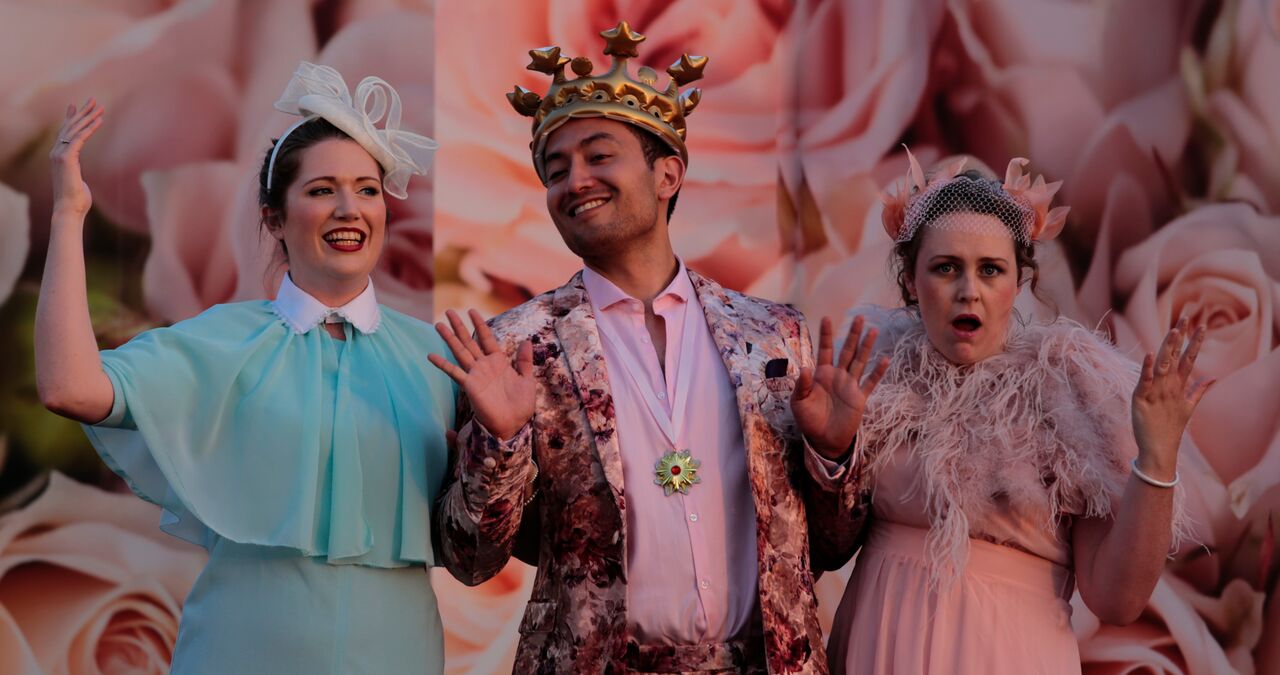 United Kingdom Bampton Classical Opera 2018 – Isouard, Cendrillon: Soloists and Orchestra of Bampton Classical Opera / Harry Sever (conductor), Westonbirt Orangery, Tetbury, 27.8.2018. (CP)
United Kingdom Bampton Classical Opera 2018 – Isouard, Cendrillon: Soloists and Orchestra of Bampton Classical Opera / Harry Sever (conductor), Westonbirt Orangery, Tetbury, 27.8.2018. (CP)

in Cendrillon (c) Bampton Classical Opera
Cast included:
Kate Howden – Cinderella
Aoife O’Sullivan – Clorinde, stepsister
Jenny Stafford – Tisbe, stepsister
Alistair Ollerenshaw – Baron de Montefiascone
Nicholas Merryweather – Alidor
Bradley Smith – Prince Ramir
Benjamin Durrant – Dandini
Production:
Director and Designer – Jeremy Gray
Costume designer – Jess Iliff
Choreographer – Alicia Frost
With a cast enjoying the comedy aspects of the long-forgotten opera, a full house was energised by dirctor Jeremy Gray and Bampton’s production. Nevertheless the plot’s vain, arrogant, ambitious sisters challenge Gray to produce a romantic Cendrillon to celebrate Bampton Classic Opera’s 25 years of unearthing and delivering lost or seldom produced operas. Those disrespectful sisters encourage their colleagues on stage to take ownership of this restored work to develop the comic energy which the Parisian patrons enjoyed during a sell-out three years which began in 1810.
That three-year run firmly established Nicolò Isouard’s supremacy in Paris as composer and helped in building his reputation as a politician. Isouard wanted a fairy-tale opera, persuading his librettist to use the Perrault fairy-tale Cendrillon, ou la Petite Pantoufle de verre. In the final few moments of Act III the glass slipper duly appears, and all ends happily. Long before this the Baron’s green slippers play a much more important role. They are thoughtfully gifted by Cinderella to the Prince’s tutor, Alidor, in disguise as a beggar, pushing a top of the range shopping trolley full of vagrant possessions, including a brass horn for an Edison phonograph of the early 1900s. Costume designer, Jess Iliff, can be forgiven these minor inaccuracies; she took every opportunity to create some truly ghastly costumes for the sisters which highlighted every unfortunate bulge, for Dandini (disguised as a Prince) an ill-fitting vulgar suit and for the Baron another garish outfit. Only the Prince and Cinderella escape Iliff’s keenness to add to the inelegance of the costumes; in comparison they were pleasingly conservatively dressed until the Act II transformation of Cinderella who is then splendidly dressed for the Ball and clasping the all-important rose given to her by Alidor.
Jeremy Gray admits the work is low on magic, a fairy story without fairies and no fairy godmother. Nicholas Merryweather as Alidor is the glue binding the plot together as his scheming sends the sisters all the wrong messages and offers the Prince a clear route to the love of Cinderella. He is well known to Longborough and Buxton Festival Opera patrons, his fine baritone voice and impressive stage presence is a big plus. Mezzo Kate Howden’s warm infectious behaviour sets her apart from the vulgarity of her selfish Vogue-reading sisters determined to trap the Prince by whatever means. Both Aoife O’Sullivan and Jenny Stafford, as those sisters, are successful spectacle-stealing performers benefitting from Alicia Frost’s exacting choreography. If ever evidence is needed of the cast taking ownership and developing the comic energy, then Act II provides it in spades.
By Act III the plot is beginning to unravel; Cinderella is back in her simple clothes fighting hard to avoid being forced to marry Dandini, now exposed as a simple squire. Cinderella remarks, ‘I didn’t like him when he was a Prince, I like him even less now he’s not a Prince!’ Whether in disguise or not, Benjamin Durrant delivers one of those appropriate unctuous performances.
Bright stunning sets, vulgar costumes, clever choreography and lots of comic energy deserve support from a lively orchestra. Shulah Oliver led resolutely, Rita Schindler provided some telling harp contributions with the twenty players capably led by Harry Sever. By tradition, the orchestra has a pit to the right-hand side of the auditorium; however, this year they find themselves on stage with actors and singers catching a glimpse of the conductor only when facing stage left. Perhaps the move to the stage was to create space for more ticket sales; if not, the musicians should return to their pit.
Harry Sever maintains a strong pace with Isouard’s tuneful melodies; sung in English, with translations by company artistic directors Gilly French and Jeremy Gray, full marks to Bampton Classical Opera on yet another clever revival – believed to be a possible UK première.
Clive Peacock
For more about Bampton Opera click here.
